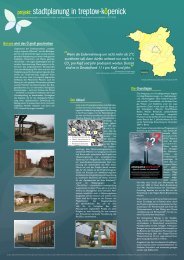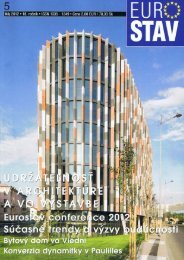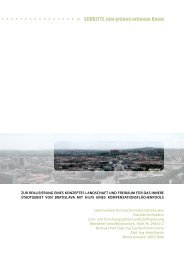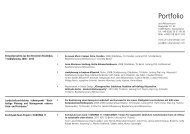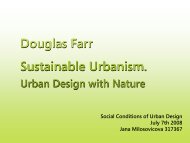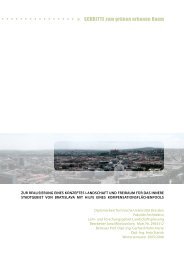Thesis document - Jana Milosovicova - Urban Design English
Thesis document - Jana Milosovicova - Urban Design English
Thesis document - Jana Milosovicova - Urban Design English
- No tags were found...
Create successful ePaper yourself
Turn your PDF publications into a flip-book with our unique Google optimized e-Paper software.
Appendix 8 The LEED-ND provision for UHI effect mitigationLeed-ND US, Canada has provisions for the Heat Island Reduction – where however with only 1 point out of 110possibly rewarded for heat island mitigating measures, the requirements for the UHI reduction are rather weak; andare not enforceable. Critique also is that the LEED-ND certification omits considering the hardscape area of façades,which due to its surface character contributes to the UHI, and avoids pursueing façade vegetating measures. See thedetails in LEED-ND provisions on UHI below. Stormwater Management has a slightly higher rating in the LEED-ND rating system, where in various certificate levels, 80 – 95% of rainwater is required to be retained, and can berewarded by 1-4 points.GiB Credit 9: heat island reduction (1 point)IntentTo reduce heat islands to minimize effects on the microclimate and human and wildlife habitat.RequirementsOption 1. Nonroof measuresUse any combination of the following strategies for 50% of the nonroof site hardscape (including roads, sidewalks,courtyards, parking lots, parking structures, and driveways):a.b.c.d.Provide shade from open structures, such as those supporting solar photovoltaic panels, canopied walkways, andvine pergolas, all with a solar reflectance index (SRI) of at least 29.Use paving materials with an SRI of at least 29.Install an open-grid pavement system that is at least 50% pervious.Provide shade from tree canopy (within ten years of landscape installation).orOption 2. High-reflectance and vegetated roofsUse roofing materials that have an SRI equal to or greater than the values in Table 1 for a minimum of 75% of theroof area of all new buildings within the project; or install a vegetated (“green”) roof for at least 50% of the roof areaof all new buildings within the project. Combinations of SRI-compliant and vegetated roofs can be used providedthey collectively cover 75% of the roof area of all new buildings (use the equation in Option 3).Table 1. Minimum solar reflectance index value, by roof slopeRoof slope SRILow (≤ 2:12) 78Steep (> 2:12) 29orOption 3. Mixed nonroof and roof measuresUse any of the strategies listed under Options 1 and 2 that in combination meet the following criterion:Area of Nonroof measures / 0.5 + Area of SRI roof / 75 + Area of vegetated roof / 0.5 ≥ total Site hardscape Area+ total roof AreaAppendices91



